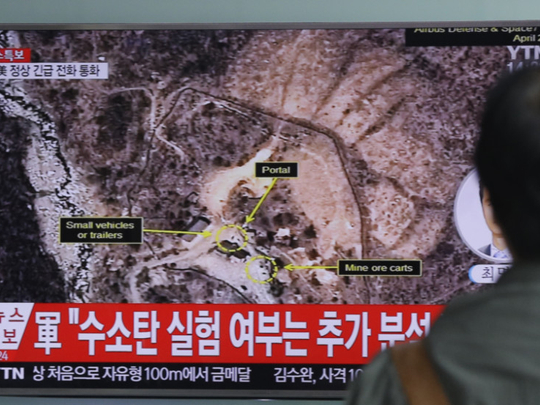
SEOUL: North Korean leader Kim Jong Un’s promise to dismantle his country’s only known nuclear test site later this month has shone the spotlight on the secretive facility near the Chinese border.
The Punggye-ri test site, located beneath a mountain in the country’s northeast, has hosted all six nuclear tests Pyongyang has conducted — most recently last September.
US President Donad Trump welcomed the move in a tweet.
North Korea has announced that they will dismantle Nuclear Test Site this month, ahead of the big Summit Meeting on June 12th. Thank you, a very smart and gracious gesture!
— Donald J. Trump (@realDonaldTrump) May 12, 2018
The North on Saturday announced that it would hold a ceremony for the dismantling of the facility between May 23-25, blowing up its tunnels in front of invited foreign media.
The announcement comes as the diplomatic push for Pyongyang to give up its nuclear weapons gathers pace ahead of Kim’s eagerly-awaited — and unprecedented — summit with US President Donald Trump on June 12.
Ideal environment
The site is located deep inside mountains in the northeastern province of North Hamgyong, which borders China.
Surrounded by high, craggy peaks and carved deep into a granite mountain more than 2,000 metres high, the test site is said to be an ideal venue to withstand the huge forces unleashed by nuclear blasts.
The presence of the site became known in 2006 when the North conducted its first nuclear test under Kim’s late father, longtime ruler Kim Jong Il.
Activities have been closely watched through satellite imagery since then.
Tunnels can be seen entering the site from different directions. The first test was staged in the eastern tunnel, the second and third in the western tunnel and the remainder in the northern tunnel, according to intelligence authorities.
Powerful blast
Tests staged at the site have demonstrated the country’s rapid progress in its nuclear programme — especially since Kim took power in 2011 and oversaw four atomic tests in only six years.
The country’s first test was largely seen as a failure and produced an estimated yield of only about one kiloton, compared to as much as 250 kilotons in the sixth — an explosion 16 times more powerful than the US atom bomb dropped on Hiroshima in 1945.
But Punggye-ri’s proximity to China has become a source of concern for Beijing, as the tremor from the sixth test was felt across the border and prompted many residents to flee their homes in panic.
Collapse claims
The growing impact of the blasts raised safety concerns over the Punggye-ri site, with some Chinese scientists warning that it could pose a major radioactive threat to the wider region.
Potential damage to the site became a topic for debate again after Kim declared last month that he would shut down the facility.
Sceptics have said the move is an empty concession by Kim as the site is already suffering from “tired mountain syndrome” and may be obsolete.
A recent study by seismologists at the University of Science and Technology of China suggested rock had collapsed under the Mantap peak, making it unusable.
But Jeffrey Lewis of the Middlebury Institute of Strategic Studies dismissed the claims, saying there is “no basis” to conclude it is no longer usable and the promised closure is “not a case of passing off damaged goods”.
Radiation fears
The North has long claimed that its nuclear tests posed no environmental threats, saying there was “no radioactive leak” after conducting tests.
But some South Korean and Japanese media reported that workers at the site or residents from the area suffered from radioactive exposure and symptoms including cancer and the births of deformed babies, citing the North’s defectors and researchers.
Such concerns prompted Seoul’s unification ministry to run medical check-ups on 30 defectors who hailed from the region for potential radioactive exposure last year.
Four of them — from the county of Kilju that includes Punggye-ri — showed symptoms that could be attributed to radiation exposure, but researchers involved in the study said they could not conclude that the health problems had been caused by a nuclear test.












